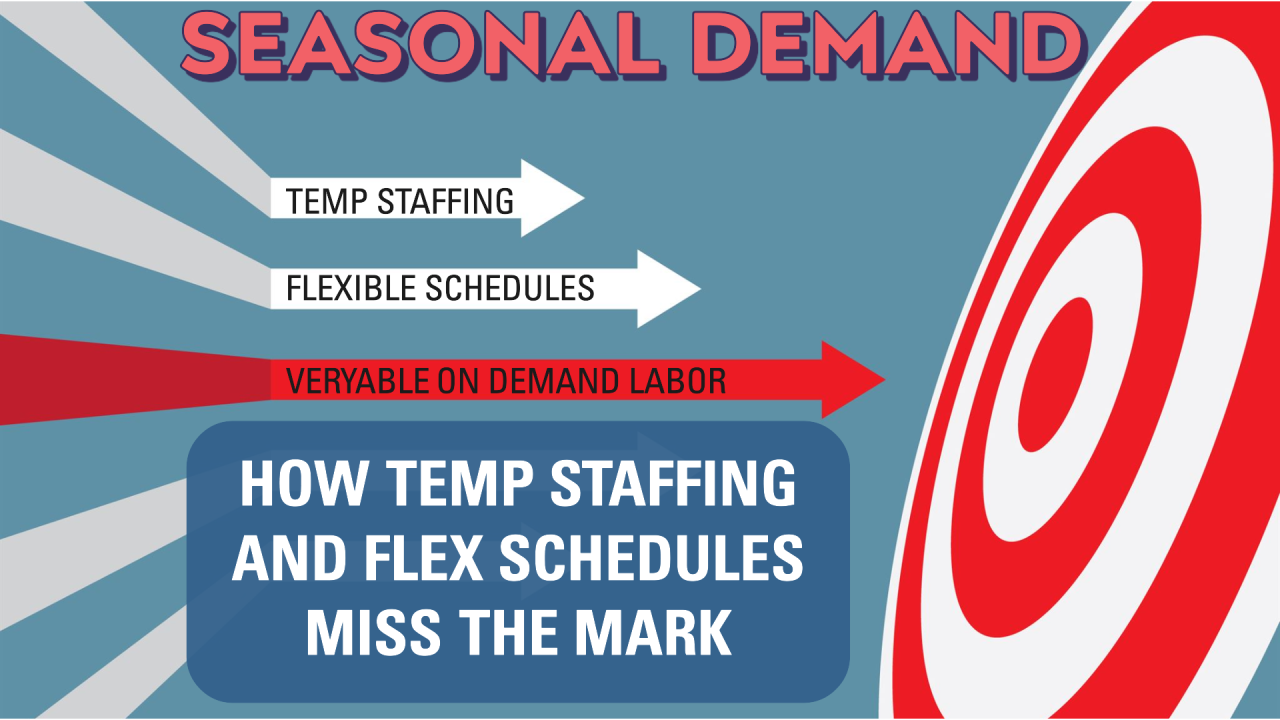How Temp Labor and Flex Schedules Miss the Mark for Seasonal Demand—and What Really Works
Manufacturing and logistics face significant challenges when demand surges seasonally. The old approach to managing these peaks involved relying on temp labor agencies, seen as a quick solution to handle workforce fluctuations. Yet, as many operational leaders know, temp labor often fails to deliver the flexibility, cost-effectiveness, and quality required to meet the demands of a fast-paced market. Flexible schedules for full-time associates are also often considered to fill these gaps, but this method often introduces added complexity and inefficiencies.
Today’s market dynamics require more than just filling roles temporarily or adjusting full-time schedules. It’s about aligning labor resources to real-time demand with minimal waste. Temp labor frequently leaves companies either short-staffed during demand spikes or overstaffed when activity slows, leading to unnecessary costs and workflow disruptions that impact customer satisfaction. Flexible full-time schedules may appear to offer a solution, but often end up straining consistent coverage and driving up overtime costs. Veryable’s model shifts labor from a static, fixed expense to a dynamic asset that adjusts to fluctuating demand, allowing businesses to operate more efficiently and customer-focused.
Responsiveness: Meeting Demand When It Happens
Temp labor requires businesses to predict staffing needs well in advance, often months ahead of peak periods. In today’s unpredictable market, these forecasts rarely align with actual demand, leaving businesses with either too many or too few workers. Similarly, flexible full-time schedules can provide short-term relief but are not adaptable enough to match sudden surges or declines in demand without frequent re-adjustment, which strains HR resources and reduces predictability in staffing.
Veryable ’s on-demand solution allows companies to adapt to real-time demand, providing skilled workers as needed, and minimizing idle time. Operations leaders can adjust their labor levels within hours instead of weeks, keeping labor costs aligned with production needs. This just-in-time approach ensures that workforce levels match immediate demand, enhancing productivity and avoiding the disruption of last-minute schedule adjustments.
Flexibility: Avoiding Fixed Costs and Underutilized Labor
Traditional temp labor operates on rigid schedules and contract terms, locking companies into fixed staffing levels that rarely reflect fluctuating seasonal demand. Full-time employees on flexible schedules add a layer of administrative complexity, requiring constant adjustments and often resulting in underutilized hours during slow periods. This inflexibility can lead to increased idle time and higher costs during slower days, while also failing to fully meet demand during peak surges.
Veryable’s model provides true flexibility, allowing companies to adjust workforce levels by the hour. Labor can be scaled up or down based on daily demand, so every dollar spent is directly tied to productivity. This eliminates the waste associated with static staffing models, helping companies avoid paying for underutilized labor or scrambling to cover peak times.
Capacity: Scaling with Demand While Maintaining Quality
When seasonal peaks hit, operations leaders need not just more workers, but skilled ones. Temp labor often struggles to meet quality standards due to limited vetting, which can lead to inconsistent productivity and errors. Flexible full-time schedules create additional strain on core staff, potentially leading to burnout or quality lapses, especially when workers are moved around to cover different shifts or roles without specific expertise.
With Veryable’s platform, companies have access to a vetted workforce that can scale up while maintaining quality. Each operator is rated based on skill and reliability, so companies are adding qualified capacity instead of simply filling numbers. This ensures that quality standards remain high even during demand surges, supporting consistency and customer satisfaction.
Cost Efficiency: Minimizing Unnecessary Spending
Temp labor involves added expenses, including agency fees, onboarding costs, and administrative overhead, which erode the initial cost savings that temp labor might promise. Flexible full-time scheduling often requires increased overtime, adding further costs, especially when core staff are repeatedly asked to cover shifts outside their typical availability.
Veryable’s on-demand platform reduces these expenses, offering a transparent cost structure tied directly to production needs. By removing agency fees and minimizing overtime reliance, companies save significantly while maintaining consistent staffing. This leaner model ensures every labor dollar contributes to value-adding work.
Choosing the Wrong Seasonal Solution Impacts KPIs
Key performance indicators (KPIs) are critical for monitoring operational health and efficiency. Temp labor and flexible full-time schedules can undermine these KPIs by creating rigid structures, inconsistencies, and overreliance on a limited workforce. By contrast, Veryable’s on-demand model supports these KPIs with adaptable solutions.
1. Labor Utilization Rate
Temp labor and flexible schedules often lead to underutilization during lulls or overworked teams during peaks.
On-demand labor solution: Utilize operators to handle unpredictable order surges, assist with inventory checks, and manage returns processing during peaks, ensuring labor usage aligns with productive output.
2. Order Accuracy Rate
Temp labor’s variable quality and the strain on full-time staff covering multiple roles can lead to increased order errors.
On-demand labor solution: Deploy skilled operators for final quality checks on outbound orders, support high-volume picking and packing operations, and manage returns inspection to maintain accuracy during peak times.
3. Cycle Time
Static temp labor and flexible full-time scheduling both struggle with unpredictable demand, leading to delays that slow down cycle time.
On-demand labor solution: Bring in additional operators for high-demand shipping schedules, fulfillment surges, and production prep work.
4. Lead Time Adherence
Temp labor rigidity and full-time flexibility challenges make it difficult to meet tight lead times.
On-demand labor solution: Access operators to handle last-minute assembly, manage urgent inventory transfers, and support expedited order processing.
5. Overtime Costs
Reliance on overtime from full-time staff or additional temp labor during peaks inflates labor costs and contributes to worker fatigue.
On-demand labor solution: Use scalable operators for weekend and evening shifts to avoid costly overtime for core staff, and fill labor gaps during end-of-quarter or end-of-year production spikes.
6. Employee Turnover Rate
Overuse of flexible full-time schedules can strain core staff, leading to disengagement and higher turnover rates.
On-demand labor solution: Supplement the core team with additional operators during peak periods to reduce workloads and prevent burnout. By leveraging short shifts and targeted project support, Veryable’s model promotes engagement and keeps core team members focused and committed, lowering turnover.
7. Fulfillment Cost per Order
Temp labor agency fees and overtime from full-time staff increase the cost per order, impacting profitability.
On-demand labor solution: Use on-demand operators during seasonal order spikes, for high-volume picking and packing, and for custom packaging tasks. Eliminating agency fees and avoiding overtime keeps fulfillment costs low, boosting profitability while delivering consistent customer service.
A New Way Forward for Seasonal Demand
The limitations of traditional temp labor, flexible full-time scheduling, and fixed-cost structures make it clear that they’re not ideal for meeting the demands of modern operations. Companies need a labor solution that aligns with agility, cost-efficiency, and quality goals—one that offers flexibility without sacrificing engagement or adding hidden costs. Veryable’s on-demand labor platform provides this answer, with a scalable, high-performance workforce that adjusts precisely to meet seasonal demands.
This approach isn’t just about covering shifts; it’s about building a labor strategy that helps companies and workers thrive. With Veryable, businesses gain a responsive, flexible workforce that keeps operations lean and high-performing, even through seasonal peaks. It’s a smarter, leaner approach to labor—one that speaks to the priorities of today’s operational leaders and meets the needs of a modern, fast-paced market.
Getting Started
To get started with on-demand labor, take 5 minutes to create your free business profile. Our team of experts will reach out shortly after to walk you through the process and ensure that your team is setup for success. If you need any assistance, please contact us.
To learn more about why Veryable is a game-changing solution for e-commerce, logistics, and packaging companies during peak season, check out our previous article:
Previous Posts
The Labor Crisis No One’s Talking About: Wasted Skill, Not Missing People
The Future of Manufacturing and Logistics
Create a free business profile today to explore our platform.






